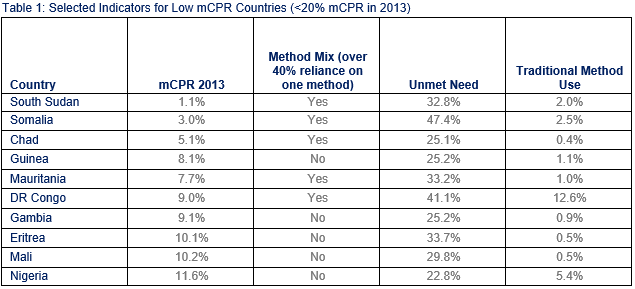Challenges in countries with low contraceptive prevalence
Low prevalence countries – defined here as countries with mCPRs of less than 15%, face different challenges from moderate to higher prevalence countries in expanding the availability of contraceptive use and increasing uptake among women with unmet need for services. Table 1 presents demographic and family planning parameters for a select group of countries with estimated mCPRs among all women of reproductive age of less than 15% in 2013. The data suggest that low mCPR may be a function of poor program response rather than one of low demand as is commonly understood.

Unmet need for family planning is high in all countries, while traditional method use varies. In four of the eleven countries, traditional method use is almost equal to or more than modern method use, while in the other six countries traditional methods form a minor part of the method mix for women who are attempting to regulate their fertility.
Countries with high unmet need and high traditional method use are most likely to respond to supply-side initiatives to expand family planning, including quality services and choice of methods. Several of the countries in the low prevalence category are in conflict zones, highlighting the need for differential strategies and methods in concert with disaster relief programs. A recent evaluation of family planning in six conflict areas in Africa found that low contraceptive prevalence was attributable in part to significant inadequacies in the supply of services, with demand for spacing ranging from 30% to 40% among women in these areas[1]. The Inter-agency Working Group on Reproductive Health in Crisis Situations (IAWG) recent update to its field manual provides programmatic guidance on providing family planning services in conflict zones.[2]
[1] McGinn et al.: Family planning in conflict: results of cross-sectional baseline surveys in three African countries. Conflict and Health 2011 5:11, Downloaded from http://www.conflictandhealth.com/content/pdf/1752-1505-5-11.pdf
[2] Inter-agency Working Group on Reproductive Health in Crises: Inter-agency Field Manual on Reproductive Health in Humanitarian Settings: 2010 Revision for Field Review New York; 2010 [http://www.iawg.net/resources/field_manual.html].